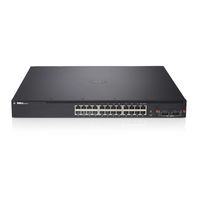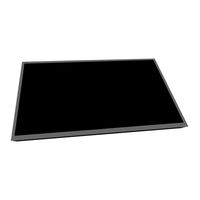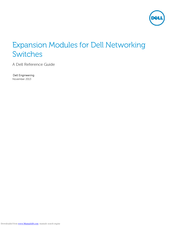User Manuals: Dell Networking N3024F Fiber Switch
Manuals and User Guides for Dell Networking N3024F Fiber Switch. We have 4 Dell Networking N3024F Fiber Switch manuals available for free PDF download: Configuration Manual, Getting Started Manual, Firmware Upgrade, Reference Manual
Dell Networking N3024F Configuration Manual (1460 pages)
stackable Layer 2 and 3 switches
Table of Contents
-
-
-
Log Messages57
-
Sflow59
-
-
Ssh/Ssl64
-
-
-
Voice VLAN78
-
Guest VLAN78
-
Double Vlans78
-
-
VLAN Routing82
-
-
-
Ipv6 Routes85
-
Ospfv385
-
Dhcpv685
-
-
-
IGMP Proxy89
-
-
-
-
-
-
Front Panel115
-
N4000 Back Panel119
-
LED Definitions121
-
-
-
-
Administrator127
-
Defining Fields132
-
-
-
-
-
-
-
-
Stack Summary185
-
NSF Summary190
-
-
-
-
AAA Overview207
-
Methods208
-
Access Lines209
-
-
Authentication211
-
Authorization212
-
Accounting214
-
-
-
-
Method Lists239
-
-
-
-
Information243
-
-
System Health251
-
System Resources252
-
RAM Log258
-
Log File259
-
Syslog Server259
-
-
-
-
CLI Banner290
-
Clock292
-
SNTP Server296
-
Slot Summary302
-
Supported Cards303
-
-
-
SNMP Overview323
-
What Is SNMP323
-
-
-
Communities335
-
Trap Flags340
-
Trap Log343
-
-
-
-
-
File System367
-
Active Images368
-
USB Flash Drive369
-
File Download370
-
File Upload372
-
Copy Files374
-
-
-
-
-
-
-
GVRP Statistics421
-
EAP Statistics422
-
Counter Summary424
-
RMON Statistics426
-
RMON Event Log432
-
RMON Alarms433
-
Port Statistics435
-
LAG Statistics436
-
Port Mirroring437
-
-
Configuring RMON441
-
-
Configuring RMON449
-
-
-
-
Port Overview477
-
-
-
Security503
-
Captive Portal543
-
-
-
ACL Overview583
-
-
Overview594
-
Limitations596
-
Examples598
-
-
-
-
VLAN Overview645
-
Switchport Modes648
-
VLAN Tagging649
-
Gvrp650
-
Voice VLAN652
-
Private Vlans654
-
-
-
Creating a VLAN682
-
Configuring GVRP695
-
-
-
-
STP Overview715
-
Rstp-Pv724
-
-
STP LAG Settings740
-
MSTP Settings743
-
-
-
-
ISDP Cache Table766
-
ISDP Statistics768
-
LLDP Statistics771
-
LLDP Connections772
-
-
Configuring ISDP782
-
Configuring LLDP782
-
-
-
-
-
Mrouter Status820
-
VLAN Querier825
-
MVR Members837
-
MVR Statistics840
-
GARP Timers841
-
GMRP Parameters843
-
MFDB GMRP Table845
-
-
Dot1Ag Overview859
-
Advertisement
Dell Networking N3024F Getting Started Manual (268 pages)
Table of Contents
-
English
6-
Contents5
-
-
Français
69-
-
-
-
-
Informations NOM
135
-
-
Português
139-
1 Introdução
143 -
-
Das Séries N20Xx144
-
-
-
-
-
Conexão AC E DC159
-
-
-
Das Séries N30Xx168
-
-
-
-
Dell Networking N3024F Reference Manual (17 pages)
Expansion Modules for Dell Networking Switches
Table of Contents
Advertisement
Dell Networking N3024F Firmware Upgrade (21 pages)
Table of Contents
Advertisement



